One of the traditionally popular application and file launchers for Mac OS X is called Quicksilver. Quicksilver, like Launchy (originally for Windows but now also available for Linux), is a keyboard launcher. To use Quicksilver, you would simply type Apple-Space, which called up its simple interface. Then you just started typing the name of the application you wanted to launch.
Quicksilver would then search through your installed programs and as you typed show you the results, until the one you wanted to use appeared in the list. You could also open documents, manipulate files, and even perform more complicated tasks. It was incredibly powerful.
As a bonus, the more you used Quicksilver, the “smarter” it got, as it learned which applications you used most often. So, when you wanted to use Firefox, it would eventually place Firefox at the top of the list (instead of Finder) after only having typed the first letter.
Linux has a program called Gnome DO, which looks and behaves almost exactly like Quicksilver. Development eventually slowed on Gnome DO, however, and then a complete rewrite was promised. That
rewrite seems to still be in the future, but a new launcher, called Synapse, may replace it for many people.
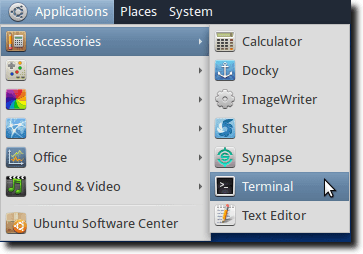
Then, type (or copy and paste) the following command:
sudo add-apt-repository ppa:synapse-core/ppa && sudo apt-get update && sudo apt-get install synapse
This is actually three commands in one (separated by “&&”). The first adds the Synapse PPA (personal package archive) to your list of software sources. The second updates those lists, and finally the third downloads and installs Synapse.
Note: Synapse can, of course, be used with other Linux distributions. The tarball can be downloaded from the project’s Launchpad page here.
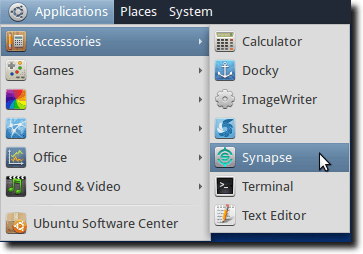
When Synapse first launches, you’ll see its main window, which is the only way to interact with Synapse, other than tweaking its preferences.
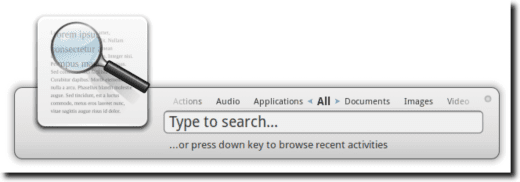
Start typing and you’ll see all the options that match what you’re typing. If there are many (if you simply typed “help,” for instance), you can scroll through the list vertically, or Synapse offers categories above the search results. You can use the right and left arrows to scroll through them.
By default you view all results, but also available are list of actions, audio, applications, documents, images, video and Internet results. Most of those are supported by default, although you can install extra data providers to enhance the results shown. All available plugins can be found in the preferences. To access the preferences, click the little dot in the upper right, and choose Preferences.
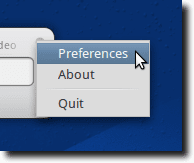
These data providers interface with Zeitgeist, a new Linux technology that is able to keep track of recently used documents. To access your Google Chrome history, for example, an extension exists that reports your history to Zeitgeist, which makes it available in Synapse.
In addition, there are data sources available for other common Linux programs such as gedit (the default GNOME text editor), Rhythmbox (a music library manager), Totem (an audio/video player), Eye of Gnome (an image viewer), Geany (a programmer’s text editor), plug Vim and Emacs.
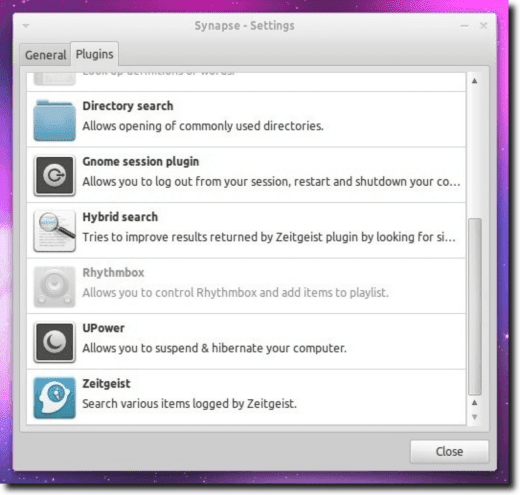
The one “missing” data source at the moment, at least for those who would love this bit of integration, is connectivity with Tracker, a common Linux search tool. Tracker has the ability to catalog metadata, as well as search “inside” documents (such as word processing documents, emails and more), so you can search not only by file name, but by its contents. Adding a Tracker data source to Zeitgeist (and thus enabling it in Synapse), would be a great addition.
Still, it’s hard to argue with Synapse, either where it right now (at a relatively young version 0.2.6), or where it’s going. With such an open framework, anyone can create new plugins, thereby extending what Synapse can do. It already looks great and works well. It’s fast to load and fast to search. You can not only launch documents and applications, but websites and even run Terminal commands.
It even has five themes by default.
There is the default theme.
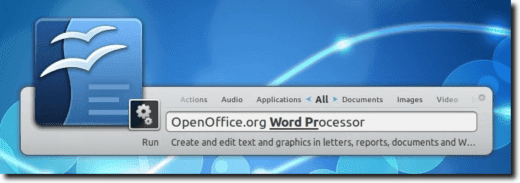
Then there is the more pixel-friendly Mini theme.

The Dual Theme is a slightly larger take on the main theme.
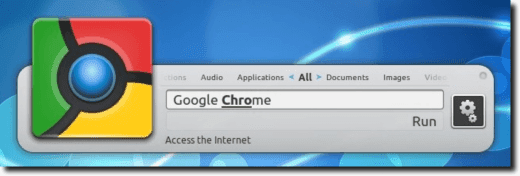
The Virgilio theme offers a nice, squarish interface.
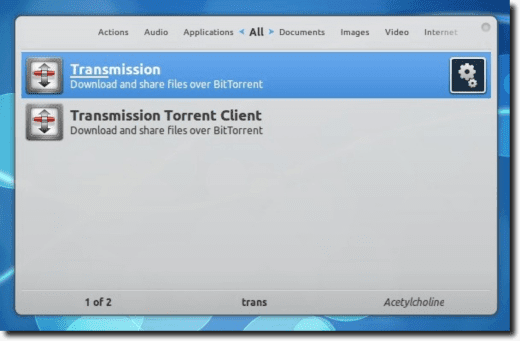
Finally, for people who miss Gnome DO, there is the Do-ish theme.
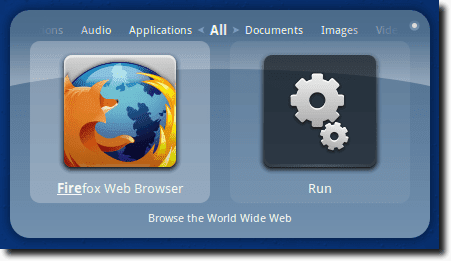
Synapse also offers nice, smooth animations, and in spite of all this, doesn’t have a lot of required libraries to run. In spite of how new it is, it seems very stable, and can already replace Gnome DO for your application launching needs. It’s great already; add a few new data sources and it just might be perfect.
Quicksilver would then search through your installed programs and as you typed show you the results, until the one you wanted to use appeared in the list. You could also open documents, manipulate files, and even perform more complicated tasks. It was incredibly powerful.
As a bonus, the more you used Quicksilver, the “smarter” it got, as it learned which applications you used most often. So, when you wanted to use Firefox, it would eventually place Firefox at the top of the list (instead of Finder) after only having typed the first letter.
Linux has a program called Gnome DO, which looks and behaves almost exactly like Quicksilver. Development eventually slowed on Gnome DO, however, and then a complete rewrite was promised. That
rewrite seems to still be in the future, but a new launcher, called Synapse, may replace it for many people.
Installing Synapse
Installing Synapse is very simple, at least if you use Ubuntu. To do so, first open a Terminal.Then, type (or copy and paste) the following command:
sudo add-apt-repository ppa:synapse-core/ppa && sudo apt-get update && sudo apt-get install synapse
This is actually three commands in one (separated by “&&”). The first adds the Synapse PPA (personal package archive) to your list of software sources. The second updates those lists, and finally the third downloads and installs Synapse.
Note: Synapse can, of course, be used with other Linux distributions. The tarball can be downloaded from the project’s Launchpad page here.
Using Synapse
Once downloaded, you’ll find Synapse in your Applications menu, under Accessories. Go ahead and open it.When Synapse first launches, you’ll see its main window, which is the only way to interact with Synapse, other than tweaking its preferences.
Start typing and you’ll see all the options that match what you’re typing. If there are many (if you simply typed “help,” for instance), you can scroll through the list vertically, or Synapse offers categories above the search results. You can use the right and left arrows to scroll through them.
By default you view all results, but also available are list of actions, audio, applications, documents, images, video and Internet results. Most of those are supported by default, although you can install extra data providers to enhance the results shown. All available plugins can be found in the preferences. To access the preferences, click the little dot in the upper right, and choose Preferences.
These data providers interface with Zeitgeist, a new Linux technology that is able to keep track of recently used documents. To access your Google Chrome history, for example, an extension exists that reports your history to Zeitgeist, which makes it available in Synapse.
In addition, there are data sources available for other common Linux programs such as gedit (the default GNOME text editor), Rhythmbox (a music library manager), Totem (an audio/video player), Eye of Gnome (an image viewer), Geany (a programmer’s text editor), plug Vim and Emacs.
The one “missing” data source at the moment, at least for those who would love this bit of integration, is connectivity with Tracker, a common Linux search tool. Tracker has the ability to catalog metadata, as well as search “inside” documents (such as word processing documents, emails and more), so you can search not only by file name, but by its contents. Adding a Tracker data source to Zeitgeist (and thus enabling it in Synapse), would be a great addition.
Still, it’s hard to argue with Synapse, either where it right now (at a relatively young version 0.2.6), or where it’s going. With such an open framework, anyone can create new plugins, thereby extending what Synapse can do. It already looks great and works well. It’s fast to load and fast to search. You can not only launch documents and applications, but websites and even run Terminal commands.
It even has five themes by default.
There is the default theme.
Then there is the more pixel-friendly Mini theme.
The Dual Theme is a slightly larger take on the main theme.
The Virgilio theme offers a nice, squarish interface.
Finally, for people who miss Gnome DO, there is the Do-ish theme.
Synapse also offers nice, smooth animations, and in spite of all this, doesn’t have a lot of required libraries to run. In spite of how new it is, it seems very stable, and can already replace Gnome DO for your application launching needs. It’s great already; add a few new data sources and it just might be perfect.


No comments:
Post a Comment